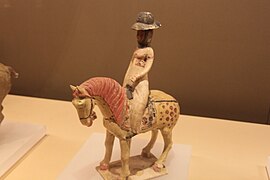| Humao | |||||||
|---|---|---|---|---|---|---|---|
 A female rider wearing the humao (veil-less hat) and a form of hood (mili) | |||||||
| Chinese | 胡帽 | ||||||
| Literal meaning | Barbarian hat | ||||||
| |||||||
Humao (Chinese: 胡帽; lit. 'Barbarian hat') is a type of brim hat which was used in the Tang dynasty by both Chinese men and women when horse-riding.[1]: 54 Women of all social ranks (ranging from palace ladies to commoners) wore humao when horse-riding since the beginning of the Kaiyuan period (713–741 AD),[2]: 311 during the Mid-Tang dynasty.[3]: 220 The humao was a type of veil-less hat (which contrasted to the weimao); therefore, it allowed for the faces and hair to be exposed.[2]: 311 [3]: 220
Gallery[edit]
Similar items[edit]
See also[edit]
References[edit]
- ^ Stepanov, T︠S︡vetelin (2010). The Bulgars and the steppe empire in the early Middle Ages : the problem of the others. Leiden [The Netherlands]: Brill. ISBN 978-90-474-4452-7. OCLC 695988846.
- ^ a b China : dawn of a golden age, 200-750 AD. James C. Y. Watt, Prudence Oliver Harper, Metropolitan Museum of Art. New York: Metropolitan Museum of Art. 2004. ISBN 1-58839-126-4. OCLC 55846475.
{{cite book}}: CS1 maint: others (link) - ^ a b Xu, Zhuoyun (2012). China : a new cultural history. Timothy Danforth Baker, Michael S. Duke. New York: Columbia University Press. ISBN 978-0-231-15920-3. OCLC 730906510.



Well, that’s interesting to know that Psilotum nudum are known as whisk ferns. Psilotum nudum is the commoner species of the two. While the P. flaccidum is a rare species and is found in the tropical islands. Both the species are usually epiphytic in habit and grow upon tree ferns. These species may also be terrestrial and grow in humus or in the crevices of the rocks.
View the detailed Guide of Psilotum nudum: Detailed Study Of Psilotum Nudum (Whisk Fern), Classification, Anatomy, Reproduction